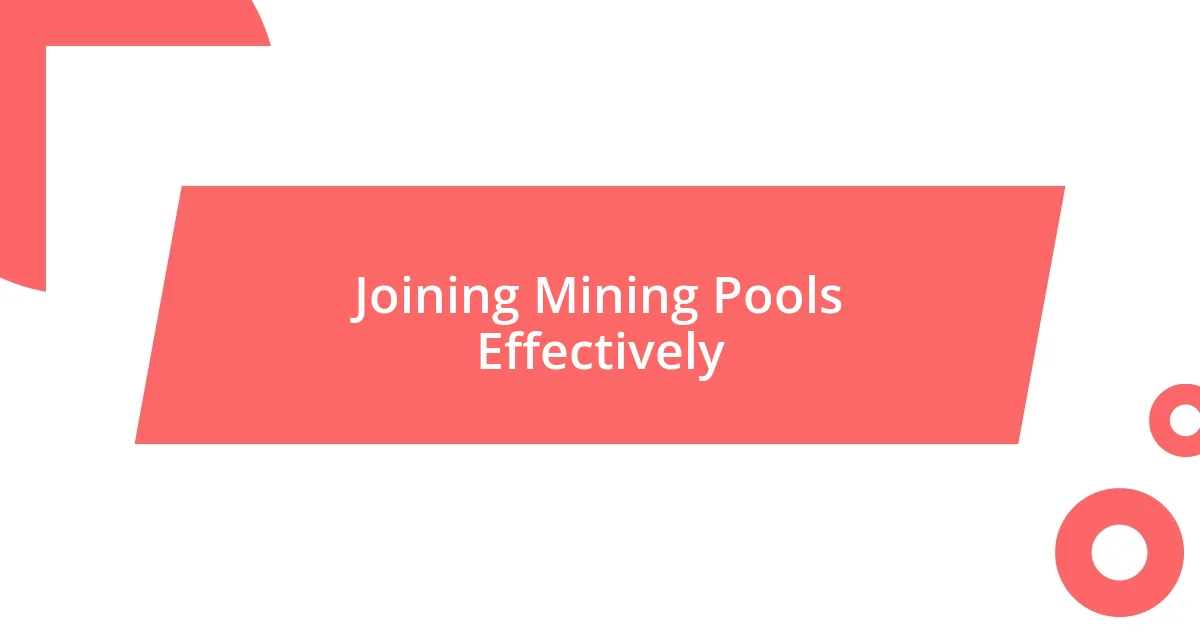Key takeaways:
- The motivation to start mining stemmed from curiosity about technology and the desire for self-discovery, reinforced by engaging with a community of like-minded individuals.
- Thorough research on cryptocurrency options was crucial, helping to clarify choices based on factors such as mining difficulty, community support, and transaction speed.
- Joining a mining pool and overcoming technical issues through collaboration and troubleshooting were significant steps in enhancing the overall mining experience.

My Motivation for Mining
When I first delved into the world of mining, it was ignited by a simple curiosity about technology and its potential—what if I could harness the power of computers to create value? I vividly remember staring at my computer screen, mesmerized by the idea that I could take part in this digital gold rush. It felt like a thrilling adventure, full of opportunities waiting to be uncovered.
The turning point for me came during a casual conversation with a friend who had started mining. He spoke passionately about the community, the camaraderie, and the shared experiences of troubleshooting rigs on late-night tech calls. I couldn’t help but wonder—could this be my chance to not only expand my knowledge but also connect with like-minded individuals? The thought of learning something new while being part of a larger movement motivated me to take the leap.
At times, I felt a rush of excitement and fear all at once—what if I failed? Yet, that uncertainty pushed me to embrace the challenge; it was that blend of anxiety and anticipation that fueled my desire to mine. Each slight victory, whether it was successfully setting up my first rig or earning my first coin, reinforced my motivation and made the whole journey feel worthwhile. It was about more than just profit; it was about self-discovery and growth.

Researching Cryptocurrency Options
As I began my journey into mining, the sheer number of cryptocurrency options available felt overwhelming. I spent countless hours researching various coins, analyzing their market viability and technological foundations. I discovered that each currency has unique attributes—some focus on privacy while others emphasize speed or low transaction fees. This realization helped me identify what I valued most in a cryptocurrency, and that made my decision-making process so much clearer.
In my research, I created a matrix comparing the top contenders to see which would best align with my goals. I looked at factors like mining difficulty, community support, and long-term potential. It was quite eye-opening! I remember feeling a mix of excitement and anxiety as I weighed the pros and cons of each. This exercise not only clarified my options but also deepened my understanding of the ecosystem as a whole.
Reflecting on my experience, I realized that thorough research acts like a guiding star in the chaotic world of cryptocurrency. Some of the insights I gained were invaluable and fuel my current pursuits in mining. I learned that being informed not only sets you up for potential financial gains but also enriches the experience with knowledge and confidence.
| Cryptocurrency | Mining Difficulty | Community Support | Transaction Speed |
|---|---|---|---|
| Bitcoin | High | Strong | 10 min |
| Ethereum | Medium | Strong | 15 sec |
| Litecoin | Low | Moderate | 2.5 min |
| Monero | Medium | Active | 2 min |

Choosing the Right Equipment
When I started thinking about mining, choosing the right equipment felt like a monumental task. I quickly realized that the equipment I selected would significantly impact my mining efficiency and, ultimately, my success. I grappled with the choices between ASIC miners, which are designed for specific cryptocurrencies, and GPU setups, known for their versatility and adaptability. It’s like choosing between a high-performance sports car and a trusty all-terrain vehicle—each has its own strengths and is best suited for different terrains.
As I dove deeper, I made a list of must-haves that helped narrow down my options:
- Hash Rate: This determines how quickly a miner can solve cryptographic puzzles. A higher hash rate means better performance.
- Energy Efficiency: Mining consumes a lot of electricity, so I looked for equipment that balanced power consumption and performance.
- Cooling Solutions: Mining rigs generate considerable heat—proper cooling extends the lifespan of the hardware.
- Initial Cost vs. ROI: I had to assess how much I was willing to invest and how long it would take to recoup that investment based on potential earnings.
I remember the moment I finally settled on a GPU rig, feeling both relief and excitement. It seemed like the best fit for my long-term goals, giving me the flexibility to mine multiple currencies as I learned more about the landscape. The act of putting it together was a hands-on experience that made me feel like I was finally entering the game, each piece of equipment symbolizing a step toward my mining aspirations. Every adjustment, every connection, felt electrifying, as if I was literally shaping my future one bolt at a time.

Setting Up the Mining Rig
Setting up the mining rig was a pivotal moment in my journey. When I finally gathered all the components, it felt surreal—a bit like assembling a puzzle where each piece directly influenced my success. I remember sitting on the floor surrounded by boxes, thinking, “What if I mess this up?” There was definitely a learning curve, and I certainly felt a blend of excitement and trepidation as I connected everything.
The act of connecting the power supply to the motherboard felt oddly satisfying. I double-checked every connection, remembering the advice I read about how a loose cable could lead to massive headaches down the line. I even got butterflies when I hit that power button for the first time; it was the moment I had been waiting for. Seeing the lights flicker on gave me a burst of adrenaline—my rig was alive!
Afterward, the configuration process began, which involved installing mining software and tweaking settings for optimal performance. I was astonished by how many things I could adjust to enhance efficiency. It made me wonder, have you ever felt overwhelmed by options and just dove in? The adjustments I made, like optimizing the fan speeds and power usage, helped me understand the nuances of mining better than I had expected. It was more than just setting up a machine; it was like unlocking a whole new world of possibilities right from my own home.

Understanding Mining Software
Understanding mining software was like stepping into a vast digital landscape, and initially, it felt overwhelming. I remember the first time I tried to install mining software; it was a mix of excitement and anxiety. There are so many different options out there—each with its own user interface and methods of operation. Did I choose the right one? I felt like I was standing at a crossroads, not knowing which path would yield the best results.
As I began to navigate through the installation process, I found resources and forums to be incredibly helpful. It was comforting to see others sharing their experiences and tips. One piece of advice that stuck with me was to always ensure that the software was compatible with my hardware. This small detail could mean the difference between maximizing my rig’s potential or facing frustrating downtime. Each successful installation moment brought a wave of relief, as if I was finally getting the hang of things.
Once I settled on my preferred software, the real fun began—tuning the settings. I distinctly recall mining my first block; the thrill of seeing those numbers tick up brought a sense of accomplishment that I had never experienced before. Have you ever had a moment where everything clicks? It felt like I was not just a miner but a part of something much bigger, engaging with a global community through code and algorithms. That instant fostered a deeper understanding of what mining software truly represented: a gateway to opportunity and innovation.

Joining Mining Pools Effectively
Joining a mining pool felt like a rite of passage for me, a way to turn my dream into a collective ambition. I still remember my first dive into the options. Should I go for a bigger pool with more hash power, or a smaller, perhaps friendlier community? I ultimately went with a mid-sized pool, where I felt I could both contribute and learn, which made the experience more satisfying. Have you ever had a tough choice that turned out to be the right one? That’s exactly how I felt.
Once I made my decision, I was greeted by a world of teamwork. The excitement was palpable—this was no longer a solo endeavor. I remember reading the pool’s guidelines and discovering how to set up my wallet address for rewards. It felt a bit like signing a contract; I was now committed to a community that shared similar goals. Seeing my initial contributions yield results was exhilarating. It felt like I was not just mining for myself but for a group of people working towards a common goal.
Communication within the pool was a game-changer for me. Engaging with other miners through chat rooms and forums provided insight I couldn’t have achieved alone. One memorable instance was when I shared a minor bug I encountered, and within hours, I learned from others who had faced the same issue. Have you ever found that the best solutions often come from sharing experiences? That support truly deepened my connection to the mining community and reinforced my belief that collaboration could lead to a richer mining experience.

Troubleshooting Common Mining Issues
I often found myself grappling with unexpected issues when mining. One common problem was persistent connectivity drops. I still remember the first time my miner went offline during peak hours. The initial panic was overwhelming. Was my internet service to blame, or was it my rig? After some troubleshooting, I learned to check my router settings and ensure that my mining platform wasn’t hogging all the bandwidth. A simple tweak resolved the issue and gave me peace of mind. Have you ever felt that knot in your stomach when technology fails? That relief as everything clicks back into place is priceless.
Another challenge I frequently faced involved fluctuating hash rates. You know, that eerie feeling when the numbers just don’t add up? I recall one evening, staring in disbelief at my monitor as my hash rate plummeted without explanation. It turned out that my mining rig was overheating due to poor ventilation. After a thorough evaluation of my setup, I rearranged my equipment, making sure everything had enough airflow. It’s amazing how such a straightforward solution can make a world of difference! I learned to routinely monitor my rig’s temperature, always asking myself, “Is this running optimally?”
Lastly, I encountered software crashes more times than I’d like to admit. I remember the frustration of watching my mining program freeze mid-session—it’s like a bad dream that you can’t wake up from! Keeping my software updated became my go-to strategy. Updating wasn’t just about having the latest features; it was essential for bug fixes and stability. I also established a routine of backing up configurations, ensuring that if a crash occurred, I could bounce back quickly. It’s incredible how being proactive can save you a ton of heartache! How do you ensure your setups are as foolproof as possible? Sharing these strategies might help us all avoid some of those dreaded hiccups together.















